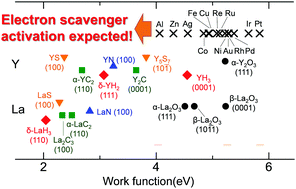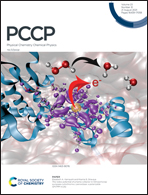Surface activation by electron scavenger metal nanorod adsorption on TiH2, TiC, TiN, and Ti2O3†
Abstract
Metal/oxide support perimeter sites are known to provide unique properties because the nearby metal changes the local environment on the support surface. In particular, the electron scavenger effect reduces the energy necessary for surface anion desorption, and thereby contributes to activation of the (reverse) Mars–van Krevelen mechanism. This study investigated the possibility of such activation in hydrides, carbides, nitrides, and sulfides. The work functions (WFs) of known hydrides, carbides, nitrides, oxides, and sulfides with group 3, 4, or 5 cations (Sc, Y, La, Ti, Zr, Hf, V, Nb, and Ta) were calculated. The WFs of most hydrides, carbides, and nitrides are smaller than the WF of Ag, implying that the electron scavenger effect may occur when late transition metal nanoparticles are adsorbed on the surface. The WF of oxides and sulfides decreases when reduced. The surface anion vacancy formation energy correlates well with the bulk formation energy in carbides and nitrides, while almost no correlation is found in hydrides because of the small range of surface hydrogen vacancy formation energy values. The electron scavenger effect is explicitly observed in nanorods adsorbed on TiH2 and Ti2O3; the surface vacancy formation energy decreases at anion sites near the nanorod, and charge transfer to the nanorod happens when an anion is removed at such sites. Activation of hydrides, carbides, and nitrides by nanorod adsorption and screening support materials through WF calculation are expected to open up a new category of supported catalysts.

- This article is part of the themed collection: 2021 PCCP HOT Articles


 Please wait while we load your content...
Please wait while we load your content...